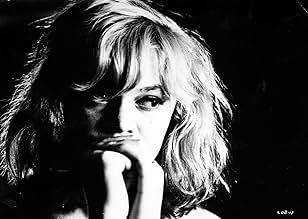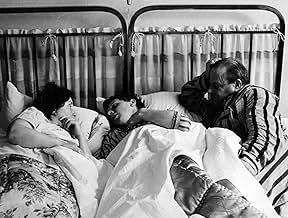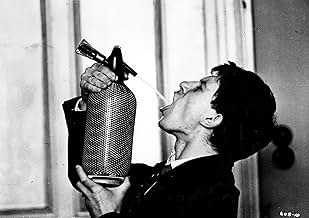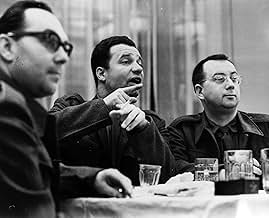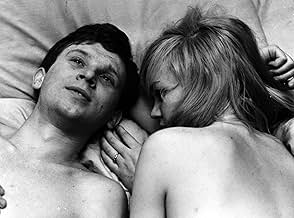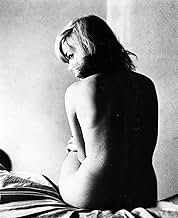ÉVALUATION IMDb
7,4/10
10 k
MA NOTE
Une jeune femme de la classe ouvrière dans une petite ville tchèque pass la nuit avec l'un des membres d'un groupe de Prague. N'entendant plus parler de lui, elle fait ses bagages et arrive ... Tout lireUne jeune femme de la classe ouvrière dans une petite ville tchèque pass la nuit avec l'un des membres d'un groupe de Prague. N'entendant plus parler de lui, elle fait ses bagages et arrive à sa porte, mettant sa famille dans le pétrin.Une jeune femme de la classe ouvrière dans une petite ville tchèque pass la nuit avec l'un des membres d'un groupe de Prague. N'entendant plus parler de lui, elle fait ses bagages et arrive à sa porte, mettant sa famille dans le pétrin.
- Nommé pour 1 oscar
- 2 victoires et 4 nominations au total
Jana Novaková
- Jana
- (as Jana Nováková)
Jindrich Heidelberg
- Reditel
- (uncredited)
Dana Valtová
- Bohunka
- (uncredited)
Avis en vedette
Andula is working-class girl living in a Czech town.She sleeps with a pianist called Milda after a party.When she doesn't hear from him, she travels to his parents place, where he still lives.Lásky jedné plavovlásky (English title Loves of a Blonde) from 1965 was the first big hit of Milos Forman.This Czechoslovakian film was nominated for the Golden Globe and Academy Award for best foreign film.In my country, Finland, it won a Jussi Award.Hana Brejchová is wonderful as Andula.Vladimir Pucholt is terrific as Milda.Milada Jezkova and Josef Sebánek are great as his parents.The dialogue is marvelous.Like when Andula and Milda are lying in bed and he explains to her how she's angular.That the woman is shaped like a guitar but she's one painted by Picasso.And there are some terrific scenes.The restaurant scenes are fantastic.Those men on their table are checking on the women on their table, trying to find a way to approach.And when Andula arrives at Milda's place and the mother can't deal with it.Great work from the Czech master.
It is true but sad that no one in the world would have known about a small Czech town named Zruc if Czech director Milos Forman had not made this film.It is a good thing that he has made it as its fresh appeal would ensure that it is remembered as a supreme example of a famous cinema movement of the sixties called Czech new wave."Lásky jedné Plavovlásky" is a touching film about sad realities, disappointments in love faced by innocent people when they pursue an idle romantic relationship.It is based on a real event which took place in Milos Forman's life when at Prague he saw a beautiful albeit a lost girl roaming in the middle of the night.We see the lives of young people especially young girls who feel bored as there is hardly any male companionship available to them.As this film was made in socialist times we also get to see the attitude of parents belonging to a socialist system.Milos Forman makes his film memorable when he deals with risks which young people take when they fall in live.He conveys that it is not so easy to continue a relationship which has remained frivolous from its inception.Loves of a blonde maintains it serious stance as there is a talk of a serious problem of dwindling male female ratio faced by many European nations.One of the most funny moments of this film include a good social experiment when an army unit is asked to move to Zruc in order to woo its lonely girls.
This is such an exquisite cinematic weave of feelings, I was taken aback. But only half of it is there, the rest you'll have to supply which is even better in a way. Films come into being after all in that space between what is there and the experience in the eye.
But first. Watch it once straight through because it's funny as hell in that gentle way the Czech know so well, just light and bitter enough to be like getting tipsy on life, delighted at the tipsiness. It's well made and well acted, you can see why Milos Forman was quickly tapped by Hollywood.
Watching it once, you'll have this as your template—a teenage girl's impressionable drift through male sexual whims, and bittersweet realization in the end of heartbreak every time. Now bring all these other things to it:
The guys are only looking to get laid, this isn't about them.
It's a story the blonde girl tells to her girlfriend using the photograph of a boy, both real and imagined. Knowing this, is knowing everything else including the seduction is her exploring by allowing herself to be explored.
The gaffe with the bottle of wine sent by horny soldiers to the wrong table, the ugly ducklings instead of the pretty blonde. But it makes its way to the right one, and we have the two soldiers go after the two girls (but not the blondie), and that subplot abandoned with inviting glances.
Now her seduction (remember, still a story she will tell) but we actually skip sex, and go straight to the intimacy and youthful joking around on the bed which is what she yearns for, connection. And as she leaves the room, she meets the ugly duckling coming back to her room after her parallel night with the soldier.
The lecturing by a teacher on girls guarding a woman's honor, and she boards the first bus out of there. Is she mad? Looking for answers?
The cut from her alone in a country road boarding the bus, to a dance floor in the city filled with young couples, to TV footage of dancing girls in the parents' home. Amazing storytelling, because it is not of the story but the air around the girl lifting her from that road to wait for him in his house.
Her being 'locked' in the house, falling asleep to the mother's incessant nagging. Waking up again, now the boy is there but he's not who she would like him to be—she watches heartbroken through a peephole (a cinematic device) as the pettiness of family life is revealed.
So this is wonderful. It ends with her telling this story better than it is.
I would change a single detail—we'd never be shown who is in either of the two photographs.
It would be about any of these girls dreaming up all we've seen. (we see them all asleep in the end)
Sex safely explored inside the fantasy, and the fantasy both 'real' and imaginary, helter skelter so you wouldn't know where last day's glances end and the pillow book starts. The ugly duckling as the blonde. It can support all that and more, excellent, excellent stuff.
In order to appreciate why this is special, watch another Czech film called Daisies (Sedmikrásky), more inventive on the surface, more irreverent on the same subject, but it doesn't hit deep. It has the images but not the life that gives rise to them, there are both here, and how.
It's so good, it rivals Celine and Julie Go Boating on my list of great films, a similar film on the layered dreaming of a girl.
But first. Watch it once straight through because it's funny as hell in that gentle way the Czech know so well, just light and bitter enough to be like getting tipsy on life, delighted at the tipsiness. It's well made and well acted, you can see why Milos Forman was quickly tapped by Hollywood.
Watching it once, you'll have this as your template—a teenage girl's impressionable drift through male sexual whims, and bittersweet realization in the end of heartbreak every time. Now bring all these other things to it:
The guys are only looking to get laid, this isn't about them.
It's a story the blonde girl tells to her girlfriend using the photograph of a boy, both real and imagined. Knowing this, is knowing everything else including the seduction is her exploring by allowing herself to be explored.
The gaffe with the bottle of wine sent by horny soldiers to the wrong table, the ugly ducklings instead of the pretty blonde. But it makes its way to the right one, and we have the two soldiers go after the two girls (but not the blondie), and that subplot abandoned with inviting glances.
Now her seduction (remember, still a story she will tell) but we actually skip sex, and go straight to the intimacy and youthful joking around on the bed which is what she yearns for, connection. And as she leaves the room, she meets the ugly duckling coming back to her room after her parallel night with the soldier.
The lecturing by a teacher on girls guarding a woman's honor, and she boards the first bus out of there. Is she mad? Looking for answers?
The cut from her alone in a country road boarding the bus, to a dance floor in the city filled with young couples, to TV footage of dancing girls in the parents' home. Amazing storytelling, because it is not of the story but the air around the girl lifting her from that road to wait for him in his house.
Her being 'locked' in the house, falling asleep to the mother's incessant nagging. Waking up again, now the boy is there but he's not who she would like him to be—she watches heartbroken through a peephole (a cinematic device) as the pettiness of family life is revealed.
So this is wonderful. It ends with her telling this story better than it is.
I would change a single detail—we'd never be shown who is in either of the two photographs.
It would be about any of these girls dreaming up all we've seen. (we see them all asleep in the end)
Sex safely explored inside the fantasy, and the fantasy both 'real' and imaginary, helter skelter so you wouldn't know where last day's glances end and the pillow book starts. The ugly duckling as the blonde. It can support all that and more, excellent, excellent stuff.
In order to appreciate why this is special, watch another Czech film called Daisies (Sedmikrásky), more inventive on the surface, more irreverent on the same subject, but it doesn't hit deep. It has the images but not the life that gives rise to them, there are both here, and how.
It's so good, it rivals Celine and Julie Go Boating on my list of great films, a similar film on the layered dreaming of a girl.
10dlpullar
I hadn't seen any of Milos Forman's work before I saw this, and it really surprised me (pleasantly). It was a really funny film, with clever characters, very realistic interactions and some surprisingly cheeseless slapstick moments. Also has a movingly downbeat finale.
I doubt many people will make the effort to watch a little known black and white Czech film from the 60s, but those that do will be rewarded.
I doubt many people will make the effort to watch a little known black and white Czech film from the 60s, but those that do will be rewarded.
Milos Forman's "Loves of a Blonde" which he made in Czechoslovakia in 1965 way before "Cuckoo Nest" and "Amadeus" tells a very simple bitter-sweet tale about a teenaged girl who works in a shoe factory in a small town. With sixteen girls to one man - her chances to find a man of her dreams were not very high. One evening, she meets an attractive and young piano player who tells her about Prague and compares her to a guitar that could've been painted by Picasso. After they spend the night together, he leaves and she travels to Prague to find him. The film has been one of my favorites for many years and my opinion did not change after I saw it again a week ago - funny, sad, tender, and realistic film about searching for love, broken promises, shattered hearts, and universality of hope.
Le saviez-vous
- AnecdotesDirector/screenwriter Milos Forman got the idea for the movie when he met a young girl with a suitcase in the streets of Prague. Her story was very similar to the one in the film.
- ConnexionsFeatured in Fejezetek a film történetéböl: A cseh új hullám (1990)
Meilleurs choix
Connectez-vous pour évaluer et surveiller les recommandations personnalisées
- How long is Loves of a Blonde?Propulsé par Alexa
Détails
- Date de sortie
- Pays d’origine
- Langue
- Aussi connu sous le nom de
- Loves of a Blonde
- Lieux de tournage
- Zruc nad Sázavou, République tchèque(formerly Czechoslovakia)
- sociétés de production
- Consultez plus de crédits d'entreprise sur IMDbPro
- Durée1 heure 28 minutes
- Couleur
- Mixage
- Rapport de forme
- 1.37 : 1
Contribuer à cette page
Suggérer une modification ou ajouter du contenu manquant

Lacune principale
What is the German language plot outline for Lásky jedné plavovlásky (1965)?
Répondre
